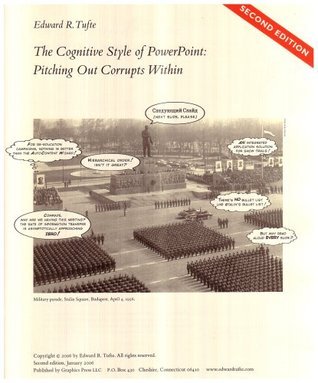- Tags:: 📚Books
- Author:: Edward R. Tufte
- Genre:: Design, Nonfiction, Business, Communication, Education, Psychology, Reference
- Source date:: 2003-01-01
- Audience score:: 8.16
- Link:: https://www.goodreads.com/book/show/17747.The_Cognitive_Style_of_PowerPoint
- ISBN:: 9780961392161
- Added to vault date:: 2025-09-28
- Finished date:: 2025-09-27
- Liked:: 5
- Cover::

Why did I want to read it?
Es un Tufte pero además referenciado por Sherry Turkle en Reclaiming Conversation.
What did I get out of it?
PP slides are very low resolution compared to paper, most computer screens, and the immense visual capacities of the human eye-brain system. With little information per slide, many many slides are needed. (View Highlight)
Information stacked in time makes it diYcult to understand context and evaluate relationships (View Highlight)
impoverished space encourages imprecise statements, slogans, abrupt and thinly-argued claims. (View Highlight)
Paper handouts for talks will help provide a permanent record for review (View Highlight)
The metaphor of PowerPoint is the software corporation itself. To describe a software house is to describe the PP cognitive style: a big bureaucracy engaged in computer programming (deep hierarchical structures, relentlessly sequential, nested, one-short-line-at-a-time) and in marketing (advocacy not analysis, more style than substance, misdirection, slogan thinking, fast pace, branding, exaggerated claims, marketplace ethics). That the PP cognitive style mimics a software house exemplifies Conway’s Law (View Highlight)
The pushy PP style tends to set up a dominance relationship between speaker and audience, as the speaker makes power points with hierarchical bullets to passive followers (View Highlight)
In their report, the Columbia Accident Investigation Board (caib) found that the distinctive cognitive style of PowerPoint interacted with the biases and hierarchical filtering of the bureaucracy during the crucial period when the spacecraft was damaged but still functioning: (View Highlight)
The choice of headings, arrangement of information, and size of bullets on the key chart served to highlight what management already believed. (View Highlight)
The closure packages showed an organization that apparently still believes PowerPoint presentations adequately explain work and document accomplishments (View Highlight)
Richard Feynman’s famous conclusion to his report on the first shuttle accident, the 1986 loss of the Challenger: “For a successful technology, reality must take precedence over public relations, for Nature cannot be fooled. (View Highlight)
What to do? For serious presentations, it will be useful to replace PowerPoint slides with paper handouts showing words, numbers, data graphics, images together. High-resolution handouts allow viewers to contextualize, compare, narrate, and recast evidence (View Highlight)